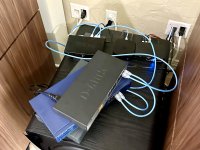Michaels HiFi
Well-known member
- Thread Author
- #81
No worries, Michael, just wanted to mention not to overlook the impact of vibration on clocks for digital "audio" devices. Cheers.
No - I appreciate you mentioning it! I didn't realize it was a "thing" so I learned something new which I appreciate.
I've got four more switches (one being a high end switch) on the way to try as well. The high end one was sent via Mail from overseas instead of DHL so it could be 2024 before it arrives. LOL

